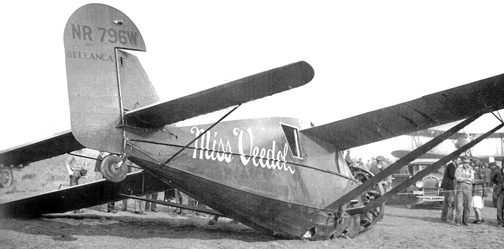

In 1931 Clyde Pangborn and Hugh Herndon,

who had the backing of the wealthy Herndon family from New York, looked to fly around the world and break the record of 20 days 4 hours set by the airship Graf Zeppelin in 1929. However, while they were still planning their flight, the record was broken by Wiley Post and Harold Gatty to 8 days 15 hours.

They still attempted the flight anyway, taking off from New York in their big red Bellanca Skyrocket, Miss Veedol, on July 28, 1931. They were met with bad conditions and their trip became futile. They were forced to abandon their efforts to break the speed record half-way through the trip, in Siberia. However, with their eyes on a $25,000 prize, they decided to attempt the first non-stop transpacific flight and flew from Siberia to Japan.

Purely for documentation, Herndon took still pictures, as well as some 16mm motion pictures, which happened to include some of Japan's naval installations. Because of that, as well as not having the proper papers to enter the country (even though they had arranged for them), they were thrown in jail. After considerable interrogation, they were fined $1,000 and released. However, they were informed that they had only one chance to take off. If there was a problem and they were forced to return to Japan, Miss Veedol would be confiscated and they would be put back in jail.

That was only one of several problems leading up to the flight. First a Japanese nationalist group, who wanted a Japanese pilot to be the first to complete such a flight, stole their maps and charts. Then Pangborn's flight calculations left no room for error. The plane had to necessarily be overloaded with fuel well beyond the manufacturer's recommendation, and his calculations would only work if they were able to ditch their bulky landing gear after take-off to reduce drag. That one was solved by a simple jury-rigged control from the cabin.
They finally got airborne on October 4, 1931 from Sabishiro (Samishoro) Beach, Misawa. Their destination, Seattle, was nearly 5,500 miles away, which would be 2,000 miles more than Lindbergh's Paris flight six years earlier.

Although the ship handled surprisingly well with its added load, immediately after take-off there was a problem. The device designed to jettison the landing gear partially failed—the wheels dropped but the struts remained. Knowing they would never make it with the struts still attached, at 14,000 feet, while Herndon flew, Pangborn climbed out onto the wing supports barefoot to kick them off.

Other than for the cold, damp weather, their flight to the Washington coast was uneventful and the engine never missed a beat. However, when they approached Seattle, it was clouded with fog. They continued on to Spokane, which was also fogged in. Because Pangborn had flown so many hours in the area around his home town of Bridgeport, he knew of a good alternate place to land—Wenatchee, where the weather was seldom cloudy. 41 hours and 15 minutes after take-off, Pangborn belly-landed the plane with minimal damage at Fancher Field. A memorial to the historical flight is located near the long-gone airport's site in East Wenatchee, and the damaged propeller is on display in a Wenatchee museum.

Miss Veedol was trucked to Seattle, where the landing gear was replaced. Pangborn and Herndon then left from Seattle and continued to New York to complete their world flight. Although news of the flight brought a lot of attention, Pangborn received little financial gain from it. However, he did continue to fly as an airmail pilot, air racer, and a test and demonstration pilot.

|



